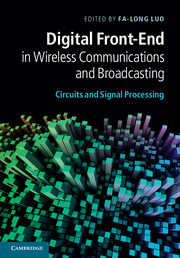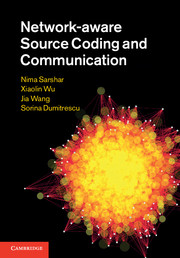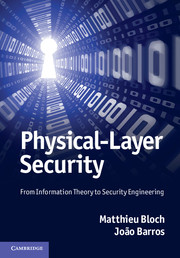Refine search
Actions for selected content:
6791 results in Communications and signal processing
7 - Cooperative games
- from Part I - Fundamentals of game theory
-
- Book:
- Game Theory in Wireless and Communication Networks
- Published online:
- 25 October 2011
- Print publication:
- 20 October 2011, pp 171-220
-
- Chapter
- Export citation
11 - Multi-hop networks
- from Part II - Applications of game theory in communications and networking
-
- Book:
- Game Theory in Wireless and Communication Networks
- Published online:
- 25 October 2011
- Print publication:
- 20 October 2011, pp 345-374
-
- Chapter
- Export citation
10 - Wireless local area networks
- from Part II - Applications of game theory in communications and networking
-
- Book:
- Game Theory in Wireless and Communication Networks
- Published online:
- 25 October 2011
- Print publication:
- 20 October 2011, pp 321-344
-
- Chapter
- Export citation
Preface
-
- Book:
- Game Theory in Wireless and Communication Networks
- Published online:
- 25 October 2011
- Print publication:
- 20 October 2011, pp xv-xviii
-
- Chapter
- Export citation
References
-
- Book:
- Game Theory in Wireless and Communication Networks
- Published online:
- 25 October 2011
- Print publication:
- 20 October 2011, pp 501-529
-
- Chapter
- Export citation
12 - Cooperative-transmission networks
- from Part II - Applications of game theory in communications and networking
-
- Book:
- Game Theory in Wireless and Communication Networks
- Published online:
- 25 October 2011
- Print publication:
- 20 October 2011, pp 375-417
-
- Chapter
- Export citation
14 - Internet networks
- from Part II - Applications of game theory in communications and networking
-
- Book:
- Game Theory in Wireless and Communication Networks
- Published online:
- 25 October 2011
- Print publication:
- 20 October 2011, pp 460-500
-
- Chapter
- Export citation
8 - Auction theory and mechanism design
- from Part I - Fundamentals of game theory
-
- Book:
- Game Theory in Wireless and Communication Networks
- Published online:
- 25 October 2011
- Print publication:
- 20 October 2011, pp 221-252
-
- Chapter
- Export citation
Frontmatter
-
- Book:
- Game Theory in Wireless and Communication Networks
- Published online:
- 25 October 2011
- Print publication:
- 20 October 2011, pp i-vi
-
- Chapter
- Export citation

Digital Front-End in Wireless Communications and Broadcasting
- Circuits and Signal Processing
-
- Published online:
- 07 October 2011
- Print publication:
- 29 September 2011

Network-aware Source Coding and Communication
-
- Published online:
- 07 October 2011
- Print publication:
- 08 September 2011

Physical-Layer Security
- From Information Theory to Security Engineering
-
- Published online:
- 07 October 2011
- Print publication:
- 22 September 2011
18 - Diversity and error compensation in OFDM transceivers
- from Part IV - Digital calibration, imbalance compensation, and error corrections
-
-
- Book:
- Digital Front-End in Wireless Communications and Broadcasting
- Published online:
- 07 October 2011
- Print publication:
- 29 September 2011, pp 531-572
-
- Chapter
- Export citation
14 - Advanced quadrature sigma-delta modulator designs for A/D interface
- from Part III - DUC, DDC, ADC, DAC, and NCO
-
-
- Book:
- Digital Front-End in Wireless Communications and Broadcasting
- Published online:
- 07 October 2011
- Print publication:
- 29 September 2011, pp 413-449
-
- Chapter
- Export citation
17 - Joint digital predistortion of I/Q modulator and power amplifier impairments
- from Part IV - Digital calibration, imbalance compensation, and error corrections
-
-
- Book:
- Digital Front-End in Wireless Communications and Broadcasting
- Published online:
- 07 October 2011
- Print publication:
- 29 September 2011, pp 502-530
-
- Chapter
- Export citation
Contents
-
- Book:
- Digital Front-End in Wireless Communications and Broadcasting
- Published online:
- 07 October 2011
- Print publication:
- 29 September 2011, pp v-xi
-
- Chapter
- Export citation
19 - Front-end architectures and impairment corrections in multimode and multi-antenna systems
- from Part IV - Digital calibration, imbalance compensation, and error corrections
-
-
- Book:
- Digital Front-End in Wireless Communications and Broadcasting
- Published online:
- 07 October 2011
- Print publication:
- 29 September 2011, pp 573-600
-
- Chapter
- Export citation
21 - Circuits and systems for digital front-ends to support multiple wireless standards
- from Part V - Circuits and system integration in digital front-end
-
-
- Book:
- Digital Front-End in Wireless Communications and Broadcasting
- Published online:
- 07 October 2011
- Print publication:
- 29 September 2011, pp 620-649
-
- Chapter
- Export citation
Contributors
-
- Book:
- Digital Front-End in Wireless Communications and Broadcasting
- Published online:
- 07 October 2011
- Print publication:
- 29 September 2011, pp xii-xvi
-
- Chapter
- Export citation
4 - System overview and front-end technologies in digital broadcasting
- from Part I - Introduction to digital front-end
-
-
- Book:
- Digital Front-End in Wireless Communications and Broadcasting
- Published online:
- 07 October 2011
- Print publication:
- 29 September 2011, pp 98-119
-
- Chapter
- Export citation
